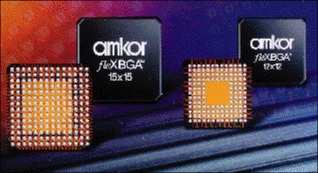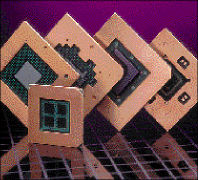1998 Editors' Roundup:
Packaging and power sources
The industry's appetite for smaller size, higher performance, and higher power handling characterized the developments in packaging and power sources in 1998. To keep pace with the latest high pin-count, high-performance semiconductors, packaging suppliers unleashed several packages designed to increase board density while being cost competitive with older packaging technologies. In power sources, the latest batteries and power supplies offered higher performance and power density in a smaller size to meet the demands of both consumer and industrial electronic products.
Chip-scale packaging continued to make inroads in the commercial packaging market. Amkor (Chandler, AZ) announced its flexBGA, an overmolded, wirebonded package on a tape substrate (see Electronic Products , May 1998, p. 23).

Amkor flexBGA
Similar in appearance to a plastic BGA, the package is available with 132 to 412 balls on pitches of 0.8, 1.0, or 1.27 mm. For a package with 256 balls, the flexBGA can reduce footprint requirements by 40% to 70% compared with a TQFP.
Flip Chip Technologies (Phoenix, AZ) also announced a chip-scale package, the UltraCSP (see Electronic Products , May 1998, p. 24). This package uses a patented wafer-scale process to produce a price per I/O that is claimed to be half that of other chip-scale packages. Offered in pitches of 0.50, 0.65, 0.75, and 0.85 mm, the UltraCSP can be processed on standard surface-mount assembly and soldering equipment.
Long active in high-density packaging, IBM (Armonk, NY) developed a glass-ceramic chip carrier (see Electronic Products , Sept. 1998, p. 23) that likewise aims at the market for affordable high-pin-count packages. Able to handle up to 5,000 I/O, the package is constructed without thin film, instead using cordierite glass dielectric.
The glass-ceramic carrier costs more than materials like alumina-ceramic. However, the package's matching thermal characteristics and higher reliability offsets the cost premium.
W.L. Gore and Associates (Newark, DE) unveiled its Via on Chip Pitch package, designed for flip-chip devices having as many as 4,000 bumps on pitches as low as 230 µm (see Electronic Products , Oct. 1998, p. 26).

W.L. Gore Via on Chip Pitch
The package (see photo ) allows vias to reside on the same pitch as the flip-chip bumps under the die. It enables die size to be minimized or signal I/O to be maximized for a given die size.
In ball grid arrays, Micro Substrates (Tempe, AZ) developed a leadless ceramic package for GaAs-based MMICs, the VBGA (Via/Pak ball grid array), which costs just $5.50 each in production quantities (see Electronic Products , Jan. 1998, p. 21). Aimed at the growing commercial wireless market, the package handles MMICs having operating frequencies from dc to 31.5 GHz. It is both far less expensive and easier to assemble onto pc boards than the microstrip and stripline packages commonly used for MMICs.
Power source introductions in 1998 also reflected the industry's emphasis on higher performance and smaller size. For instance, in batteries, Duracell (Bethel, CT) added muscle to its conventional alkaline battery to meet the requirements of high-power, high-drain-rate consumer products (see Electronic Products , April 1998, p. 23). Designated the Ultra, the alkaline battery provides up to 50% longer life than ordinary alkalines. The battery comes in AA and AAA four packs.
Development of battery technologies such as lithium-polymer also continued for applications as diverse as electric vehicles and backup power systems. 3M (St. Paul, MN) and the Montreal, Canada-based utility Hydro-Quebec have been designing lithium-polymer battery packs that can operate an electric vehicle over a minimum 150-mile range (see Electronic Products , March 1998, p. 24). The solid lithium-polymer battery will not leak and can be easily produced in rolls or stacks to form modules supplying the amount of power needed.
In power supplies, Artesyn Technologies' (Eden Prairie, MN) BXB75 dc/dc converter (see Electronic Products , March 1998, p. 122) uses a cascaded buck regulator to produce full-load power on both 3.3- and 5-V outputs. By allowing the maximum current output to be taken in any ratio from either output, the buck-regulator-based converter can address changing power needs without the need for redesign or requalification of the converter.
American High Voltage (El Cajon, CA) unveiled its Millenium 2000 high-voltage supply, rated at 5,000 V in a case measuring just 60 (W) x 50 (L) or 70 (L) mm (see Electronic Products , May 1998, p. 97). The supply uses a resonant pulse-width-modulated topology to achieve 85% efficiency and reduce size.
Surface-mount power converters also continued to emerge. Ericsson (Richardson, TX) introduced its PKF 5611 SI, the first surface-mount dc/dc converter with a 4:1 input range (see Electronic Products , Jan. 1998, p. 89). The 6-W converter is packaged in tubes or trays for automatic insertion.
–Spencer Chin
Advertisement





